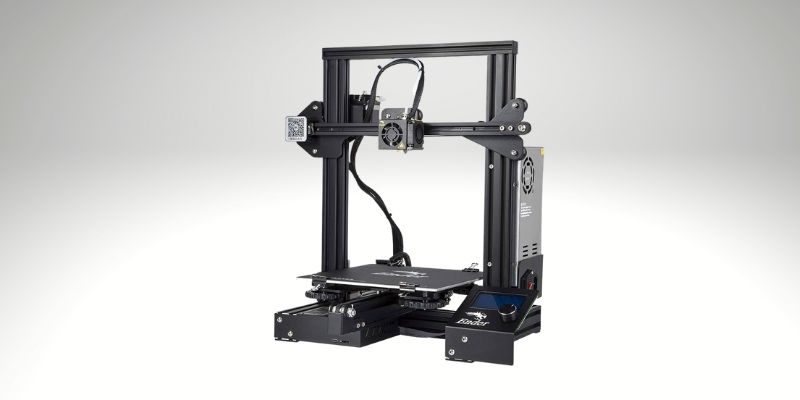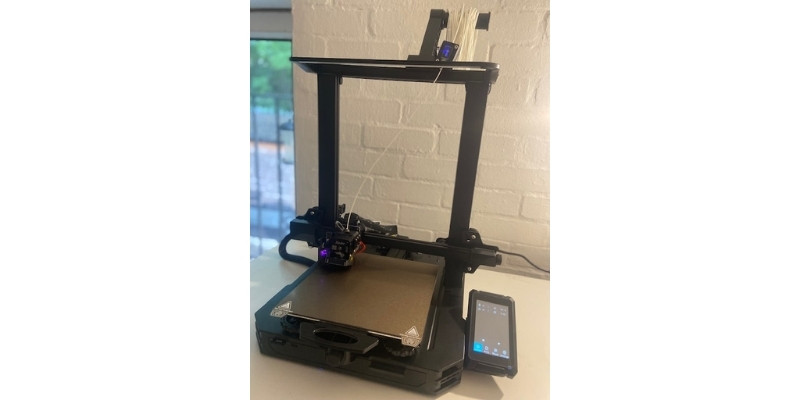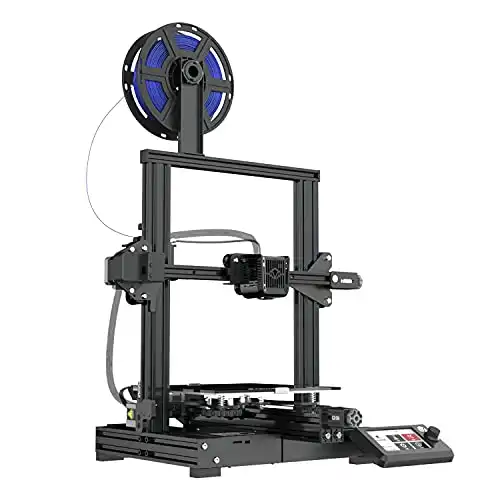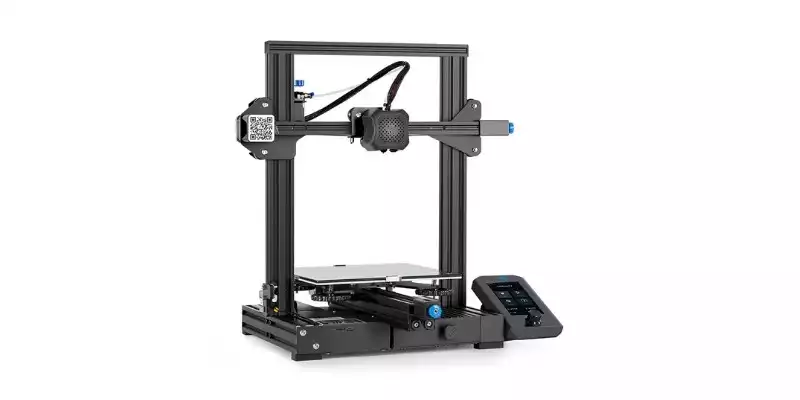With $200 in hand, it’s entirely possible to pick up a reliable starter 3D printer. To help steer you towards your best options and avoid the duds, we’ve pieced together this guide to the best 3D printers under $200.
Long gone are the days of prohibitive prices for finicky DIY kits. Entry-level printers now produce good quality prints and a much more reliable printing experience.
|
|
|
|
4.5
|
4.7
|
|
|
$189
|
|
|
Read on for our top picks; each guaranteed to make the most of your $200.
Best 3D Printers Under $200
1. Creality Ender 3 – Top Pick Overall
- Price: Check latest price at Creality here / Amazon here
- Build volume: 220 x 220 x 250 mm

Pros
Excellent performance for the price.
Makes high-quality prints reliably.
Works well with lots of different filaments.
Cons
Comes as a kit although it is easy to assemble.
There are more advanced versions available.
Few other printers have spawned quite as many clones as the classic Creality Ender 3, a testament to its ongoing appeal to thrifty makers and its position as a benchmark for inexpensive hobby printers. After all, imitation is the sincerest form of flattery.
While an open-source printer teaming with upgrade and tinkering options by design, the Creality Ender 3 veers sharply away from dime-a-dozen budget kit printers in favor of an uncomplicated, semi-assembled build. It nails the basics, handing you the keys to a reliable machine capable of decent print quality.
Turning to specifics, the Creality Ender 3 comes decked out with a 220 x 220 x 250 mm build volume, surprisingly decent for the price with enough space to craft relatively large parts and even multiple quantities of the same. The print-resume function is also worth bringing up, if only because it has no business being equipped on a sub $200 printer. Hats off to Creality for squeezing it in.

Alongside, Creality has thrown in a BuildTak-style heated bed, hitting a peak of 110°C. That’s theoretically enough for ABS if you’re game for tinkering your way to a successful print. The Creality Ender 3 has manual bed leveling, as expected for a printer under $200, and tricky control dial LCD; not ideal, but par for the course here.
If you’re looking for one of the ‘the best’ 3D printers under $200, we have no issues recommending the Creality Ender 3, even though the printer has hit veteran status now. It’s one for beginners eager to claw their way up that steep learning curve, as well as hobbyists limited by a tight budget.
2. Voxelab Aquila
- Price: Check price on Amazon here
- Build volume: 220 x 220 x 250 mm

Pros
Cheapest and best-selling 3D printer around.
Good build volume for the price.
Effective for a beginner printing PLA.
Cons
Not as accurate as more expensive printers.
While the Voxelab Aquila unabashedly channels the Creality Ender 3 in both design and price, there’s enough here to make it a viable alternative to the budget king for beginners. The main reason is that the Voxelab Aquila doesn’t float around the $200 mark but well under, often as low as $160-$170, a small price to pay for a confident little printer that’s a genuine pleasure to use.
It’s fairly remarkable what Voxelab offers for the price. A 220 x 220 x 250 mm build volume provides ample room to craft decently-sized prints, a heated carborundum glass bed shines with both PLA and ABS filament, and a color screen makes for easy navigation. Then there’s a 32-bit silent motherboard, filament auto-feeding, silent stepper motors, and open-source slicer support to cap things off.
Like all printers in this category, there are trade-offs, namely manual bed leveling, SD card connectivity, and hands-on assembly, though miles away from the complexity of piecing together a full-on kit printer. Beginners up for a challenge shouldn’t be put off, and that’s where we see Voxelab Aquila hitting its stride: it’s a superb novice printer that produces surprisingly good prints for the price.
There’s also the Voxelab Aquila X2, fundamentally the same printer, but with a filament sensor thrown in with a slight price jump to match.
Alternatively, for those looking to save a bit more cash, there’s the ultra-budget Voxelab Aquila C2. Voxelab has swapped out the color LCD for a mono display, shifted the supply from underneath to the side, and removed some of the metal plating on the base on the printer.
In our estimation, the savings aren’t worth the downgrade, and you’re better served spending a little more for the full-fat Voxelab Aquila.
3. Monoprice Mini Delta V2 – Best Fast 3D Printer Under $200
- Price: Check price on Amazon here
- Build volume: 110 x 110 x 120 mm

Pros
Fast for such a compact design.
Sturdy and durable.
The aluminum steel frame makes it precise and prevents vibrations.
Cons
Can’t work with flexible filaments.
Small but mighty, the Monoprice Mini Delta V2 is a beginner-friendly speed demon, courtesy of Monoprice opting for a Delta design rather than the Cartesian design found on most $200 printers. It’s fast, really fast – 170mm/sec – and won’t break the bank.
Unlike most printers in this price range, the Monoprice Mini Delta V2 ships fully assembled and ready to print. Features like automatic bed leveling, a color touchscreen, Wi-Fi connectivity, and support for PLA and ABS help in that respect, too, removing many of those time-sapping initial stumbling blocks. It’s also anchored to an all-metal frame and prints at a reasonably low 30dBA.
Plug and play appeal aside, the Monoprice Mini Delta V1’s overall print quality is good for the price, aided by a 40‑200 microns resolution suited to delivering strong all-around details and finish. With a tight 110 x 110 x 120 mm build volume, the Monoprice Mini Delta V1 has its limits. Still, for a first printer, primarily used to experiment and learn, there’s enough print area for parts like small figurines, decorative pieces, and modest household items.
While Monoprice is trying to bring a pro-grade printer’s convenience and ease of use to the low-cost category, the Mini Delta V2 has experimentation potential thanks to full open-source slicer compatibility. It pairs beautifully with the likes of Cura, for example.
If you’re nervous about tackling a kit or semi-assembled printer and want easy printing above all else, we highly recommend the Monoprice Mini Delta V2. It’s versatile, and most of all, dirt cheap for what amounts to a robust set of features.
4. Voxelab Proxima 6.0 – Best Resin 3D Printer Under $200
- Price: Check price on Amazon here
- Build volume: 130 x 76 x 155 mm

Pros
One of the few resin printers available for less than $200.
Comes with a 3.5-inch touchscreen.
Cons
Bang average build volume.
Flashforge’s decision to pump out budget-friendly printers under the Voxelab name has produced some low-cost gems, not least the Voxelab Proxima 6.0, one of the few resin printers available for less than $200.
The appeal is clear here: the Voxelab Proxima 6.0 undercuts competing resin printers like the Elegoo Mars 2 while still offering fundamentally the same features, and more importantly, on par overall print quality. For tabletop gamers, collectors, and amateur model makers, it delivers all the precision and fine detail we’ve come to expect from the big entry-level resin players.
You’ll find a boilerplate 6-inch 2K monochrome LCD pushing 50 microns XY resolution, a smack-bang average 130 x 76 x 155 mm build volume, and welcome niceties like a 3.5-inch touchscreen and compatibility with ChituBox, Lychee, and Voxelab’s in-house VoxelPrint slicer, a basic reskin of FlashPrint.
Read more: the best SLA slicers
The Voxelab Proxima 6.0 arrives fully assembled, standard stuff for resin printers. The only barrier to firing up that first print is an assisted bed leveling process that’s quick and over in seconds.
While we’d be the first to recommend low-cost resin printers like the Elegoo Mars 2 and the Anycubic Photon Mono range, there’s no question that the Voxelab Proxima 6.0 offers an almost identical printing experience for less than $200. Beat that, and we’ll reassess, but for the time being, the Voxelab Proxima 6.0 is the best resin 3D printer under $200.
5. Anycubic Mega Zero 2.0
- Price: Check at Anycubic here / Amazon here
- Build volume: 220 x 220 x 250 mm

Pros
Beginner-friendly.
Decent build volume.
Cons
No touchscreen or WiFi.
The new kid on the ultra-budget printer block is another printer born from the Creality Ender 3’s enduring legacy, the Anycubic Mega Zero 2.0. New in the sense that Anycubic has slapped on a 2.0, but a known quantity as it borrows heavily from the shelved original Mega Zero.
The upgrades are there, not least a new heated bed that sees the AnyCubic Mega Zero 2.0 fit for PLA and trickier ABS. It boasts an average 220 x 220 x 250 mm build volume equal to the other printers on our list.
Anycubic has also woven in an easy manual bed leveling system and painless, modular assembly, so even though there’s some hands-on setup, it won’t baffle beginners. The magnetic bed helps the removal of prints, another solid, user-friendly feature worth mentioning.
Overall, it’s a simple, unassuming printer that stretches those $200 to great effect. It’s a gateway printer for those curious about 3D printing but conscious of keeping the wallet-hit to a minimum while making sure a passing interest has the makings of long-term hobby. If you’re looking for something a little different from the Ender 3, not to say something more modern, the Anycubic Mega Zero 2.0 is well worth considering.
Buyer’s Guide- Factors To Consider
3D Printer Technology
By virtue of sitting on the lower end of the 3D printer pricing scale, the best 3D printers use one of two printing technologies.
FDM
Fused deposition modeling is an additive technology whereby an extruder heats filament and deposits it layer by layer to create a print. Most, if not all, sub $200 printers employ FDM technology. Generally, FDM printers offer layer resolutions of around 100 microns.
Resin
Resin printers use a targeted UV light source applied to photo-sensitive liquid resin to cure or form a print layer by layer. The best resin 3D printers under $300 offer layer resolutions below 50 microns for parts with higher precision, finer details, and smoother finish than FDM printers.
Resin printers priced under $200 are generally less common than FDM due to the complexity and higher cost of the underlying technology.
Material Types
At $200, it’s worth keeping in mind that material compatibility is limited. Most FDM printers can handle PLA and possibly ABS, but the options are slim beyond that.
PLA, or polylactic acid, is a thermoplastic with a low melting point and is arguably the easiest material to print for hobbyists and amateurs. It’s suited to decorative parts, low-stress household items, and rapid prototyping. It’s flexible, odorless, biodegradable, and affordable.
ABS, or Acetonitrile Butadiene Styrene, is a tough, durable thermoplastic with a relatively high melting point. Makers favor ABS for parts subject to stress, weathering, and repeated use. ABS is inexpensive but trickier to print and produces smelly fumes that can be harmful when inhaled.
Resolution and Layer Height
Although there are many factors at play when it comes to the resolution of a print, layer height offers a quick-glance estimate of a printer’s precision. For FDM printers under $200, 100 microns is standard and sufficient for a good overall print quality. 50 microns and below are typical for resin printers, enough for feature-rich parts.
Build Volume
When shopping around for a 3D printer, be sure to consider the build volume on offer. Build volume indicates the maximum size print a machine can produce.
In the $200 range, you’ll find average-sized build volumes roughly around 220 x 220 x 250 mm, matching the specifications of the Ender 3. This grants enough room for a good range of 3D parts, including household items, multiple of the same small part, models, toys, and more.
Resin printers have a much smaller build volume, offset by printing higher quality parts with more detail and accuracy.
Open and Enclosed Frame/Chamber
Other than enclosed resin printers, all $200 3D printers feature an open frame design due to the lower manufacturing costs. In practice, this means the parts are readily accessible, helpful for tinkering, modifications, and upgrades.
There are downsides, most pronounced when printing with ABS, which ideally require an enclosed chamber to maintain stable ambient temperatures. When ABS cools too quickly, the material is prone to warping and curling. An enclosed chamber helps mitigate these errors by slowing the cooling process.
Bed Leveling
Most 3D printers under $200 have manual or assisted bed leveling, requiring some hands-on time with the printer for proper calibration. And delta 3D printers generally have more complex leveling and calibration than Cartesian printers.
FAQs
You may also be interested in other price range 3D printers:
- Best 3D printers under $300
- Best 3D printers under $500
- Best 3D printers under $1000
- Best 3D printers under $2000







